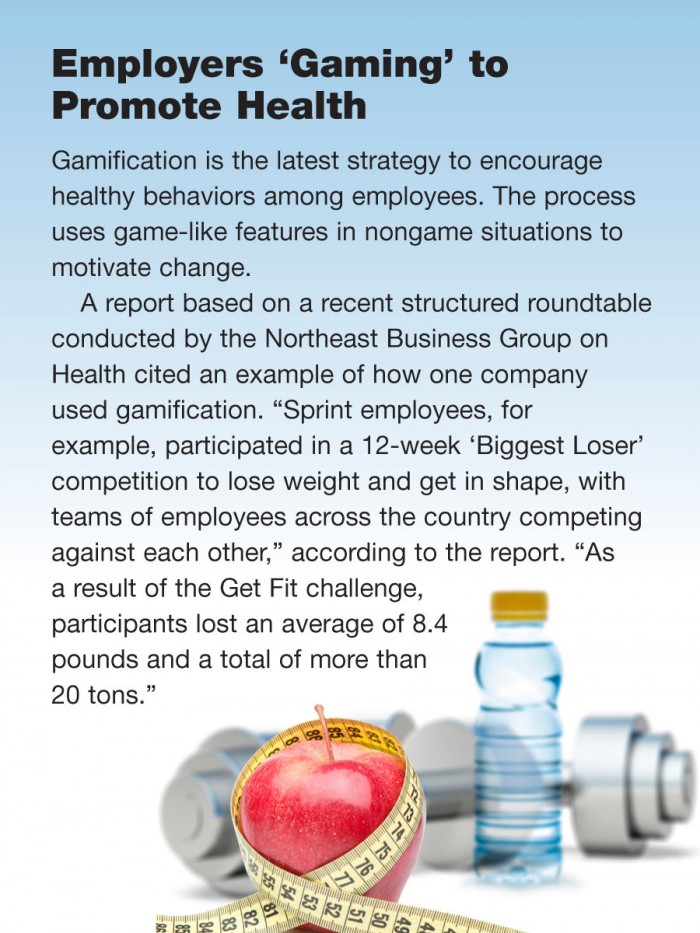The Cost of Obesity
Report Addresses Need for Effective Obesity Programs
Overweight employees have twice as many workers’ comp claims as other employees, says a new report. They generate an average of more than seven times the medical claims cost than normal-weight employees and take between six and nine more sick days per year.
Overweight and particularly obesity is one of the top health challenges for employers who “need help figuring out how to implement programs that work,” according to the Northeast Business Group on Health. The NEBGH’s newly released report, Weight Control and the Workplace, examines the obstacles and some successful practices for addressing overweight employees.
“Overweight employees cost employers more than $73 billion each year and put themselves at risk for diabetes, heart disease, arthritis, and other chronic illnesses,” said Laurel Pickering, president and CEO of NEBGH. “Employers, health plans, and health care providers need to come up with coordinated, compelling approaches that engage employees in managing their weight in order to stem skyrocketing health care costs and improve public health.”
Pickering’s comments and the release of the report follow a structured roundtable the group conducted with employers and health plans earlier this year. The 13 participating organizations discussed obesity’s impact on employee health and costs and reviewed current strategies and those being considered to identify potential opportunities and best practices.
The Problem
“The average medical claims cost per 100 employees is $51,019 for obese employees versus $7,503 for the non-obese — a staggering 7.3 differential,” the report says. “Obese men take six more sick days a year than non-obese men; obese women take 9.4 more days a year than their non-obese counterparts. The resulting obesity-related absenteeism costs employers about $6.4 billion a year.”
Presenteeism is another major cost driver among obese workers. Employees who come to work despite illness often are less productive.
“The productivity-related costs of presenteeism more than double the medical expenses for obese employees compared to non-obese employees,” the authors report. “For a company of 10,000 employees with an average annual salary of $50,000, presenteeism can cost employers between $7 million and $8 million per year.”
While employers recognize the problem of overweight/obese employees, they face challenges. The stigma associated with being overweight or obese prevents some affected employees from participating in programs that might help and also deters discussions with the employees.
Persuading employees to participate in weight control programs is another obstacle, the roundtable participants said. Employees may raise questions such as “what’s in it for me?” and “where do I sign up?” The authors suggest having dedicated staff to promote wellness initiatives.
“One of the most cost-effective ways to enhance patient engagement is having employees meet one-on-one with a benefits provider,” the report says. “In fact, 96 percent of employees who meet individually with benefits counselors say it improved their understanding of their benefits package. Lack of knowledge and information about health care resources affects participation, and this lack is significantly higher among younger workers, less educated workers and lower-paid workers.”
The American Medical Association’s recent official recognition of obesity as a disease may also help address the problem by increasing physician engagement in identifying individuals for intervention.
Possible Solutions
Employers have been trying to promote overall health care. Offering healthier food in cafeterias, on-site exercise programs, and comprehensive wellness programs are popular, but dealing with obesity and weight management has been more problematic.
“Intervention efforts have been successful by recognizing there is no single solution but that approaches can be shaped to fit each individual’s needs,” according to the report. “Employers are also beginning to embrace alternative interventions to weight control such as pharmacological therapies, bariatric surgery, and innovative technology approaches in order to engage more of their population.”
While drug therapies for weight control had previously been limited, new medications could impact employer-sponsored weight management programs. However, barriers to their access could be problematic.
 “The roundtable recommended a review of access considerations, including formulary coverage and pre-authorization, to better understand issues that may need to be addressed,” the report says.
“The roundtable recommended a review of access considerations, including formulary coverage and pre-authorization, to better understand issues that may need to be addressed,” the report says.
The use of smartphones, tablets, and social media can also assist in weight control. Apps that provide self-monitoring tools, for example, can track a user’s meals and exercise throughout a day.
Behavioral intervention strategies are also shown to be effective in weight management efforts. The programs combine education with motivational support both online and face-to-face.
These programs typically include biometric screenings, risk assessments, educational materials, access to fitness centers, lifestyle and behavior coaching, and group fitness challenges. Also gaining in popularity among employers is competition.










